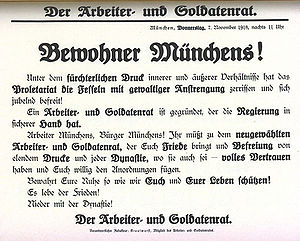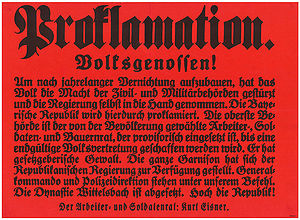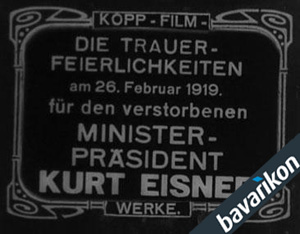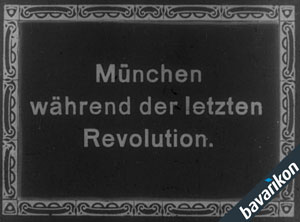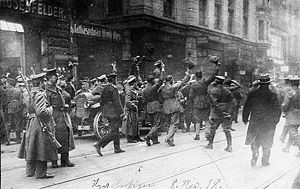
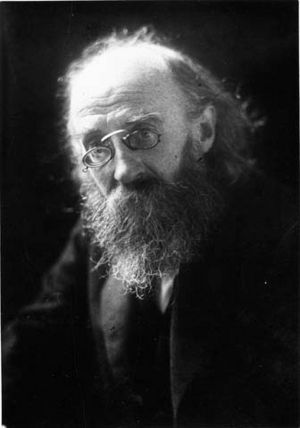
On 7 November 1918, a small group of left-wing oppositionists led by independent Social Democrat Kurt Eisner (1867-1919) managed to overthrow the Bavarian King Ludwig III (1845-1921, ruled 1912/13-1918) in Munich. The declared aims were the immediate end of the war and the transformation of the state into a parliamentary democracy. The success was all the more astonishing as it was achieved without serious resistance and without any bloodshed at all. With the fulfilment of the immediate objectives, the minimal consensus that had made the overthrow possible was, of course, soon eroded. This mainly became clear through the formation of an extreme left, which was aiming at a pure council rule, and the initially still timid formation of a militant right, which was working towards the restoration of an authoritarian nation state. Eisner's assassination on 21 February 1919 was the result of the political conflicts that had gradually intensified since the beginning of January and created a dangerous power vacuum. The government under Johannes Hoffmann (1867-1930), which was only appointed after a long tug of war, failed to assert itself against the central council bodies and to prevent the proclamation of the "Bavarian" soviet republic. Its suppression at the end of April / beginning of May 1919 ended the revolution and led in the medium term to the establishment of the “Ordnungszelle” (Cell of Order) Bavaria. Due to its complex history, the Revolution of 1918/19 is one of the key and most controversial events in recent Bavarian history.
Terminology
Revolution is generally understood to mean the violent overthrow of an existing state and social order. This characteristic also applies to the events of 7 and 8 November 1918 in Munich and the subsequent spread of the movement throughout Bavaria. This must be emphasised above all in relation to parts of older research, which was only able to recognise a collapse of the old order in the German Revolution (see Rürup and Hürten). However, there were also some researchers with an Orthodox-Communist attitude who found the concept of the revolution of 1918/19 difficult.
In fact, the revolution in Bavaria shows obvious differences to both the French and Russian October Revolutions, which traditionally set the standard for successful revolutions. In addition to the absence of physical violence, the failure to change elites also is to be mentioned here. These peculiarities were not just to do with the complete capitulation of the old rulers and the willingness of officials to stick to the new facts. Revolutionary research has rather shown that the success of a revolutionary movement in highly developed industrial societies presupposes that the functionality of the administration, economy and infrastructure is maintained. The tense supply situation, the demobilisation of the army and the conversion of the war economy to civilian production therefore imposed tight constraints on the revolutionary movement in Bavaria.
It was indeed a proletarian revolution with regard to the supporting classes. In the end, however, it was above all liberal-bourgeois demands that were permanently anchored in the constitutional reality. This had to do not least with the fact that the revolution in Bavaria, which was strongly dominated by agriculture, was largely limited to cities and industrial centres, while there was little support in the rural countryside. Although approaches to achieving a proletarian dictatorship are apparent, the elimination of parliamentary democracy in favour of a soviet republic remained an episode that was limited in time and place, but was extremely influential in the history of mentality.
State of Research
The Revolution of 1918 is one of the best studied subjects in recent Bavarian history. Hans Beyer (born 1920) already published a complete Orthodox-Marxist representation in 1957. In 1967 Allan Mitchell (born 1933) wrote a monograph on the subject, which is still authoritative today.
A wealth of individual studies have now put their statements and evaluations into perspective. Karl Bosl (1908-1993) and his students deserve special credit for this achievement. In a broad spectrum of studies, they mainly dealt with the preconditions of the revolution and indicated serious social conflicts that had already emerged before the First World War. The interest aroused by the student movement of the 1960s in the workers', peasants' and soldiers' councils led at the same time to the first corresponding studies. While Bavarian regional historiography was still strongly focused on the urban centres of Munich and Nuremberg in the late 1960s and 1970s, more recent studies have also looked at the conditions in the peripheries.
Nevertheless, desiderata remain: surprisingly, the events within the Bavarian “Heimatarmee” (replacement army) have been insufficiently studied. Little is known about the role played by the extreme left, that is anarchists, Spartacists and communists, in the revolutionary events. The interim phase between Eisner's assassination and the proclamation of the Soviet Republic, as well as the stage of Communist Council rule would undoubtedly also merit a more in-depth analysis. An investigation into how the events in Munich were perceived abroad and particularly in the victorious states would also be of great interest.
Causes of the Revolution
The fall of the Bavarian royal family was caused first and foremost by the upheavals that the First World War triggered in the state and society. However, structural causes reaching back further can also be identified. Unresolved problems from the pre-war period were among others:
- The loss of the Bavarian monarchy's authority, which began with the mental illness of Ludwig II of Bavaria and was further promoted by the lack of the rulers' political assertiveness
- the political influence of the bureaucracy not provided for in the constitution,
- the growing weight of political parties that were also disregarded in constitutional law,
- the emancipatory urge of the workers' movement and the newly emerging women's movement, as well as
- the social issue raised by industrialisation.
However, confidence in the state apparatus was only shaken in the long term by the supply shortages caused by the war, the hardships of rationing, and the complete military capitulation that blindsided large sections of the population. The assumption that rapid parliamentarisation would bring Germany more bearable peace conditions quickly became popular. The failure of the replacement troops stationed in Munich also had to do with their imminent deployment to defend the country's borders. It turned out that the soldiers were no longer willing to risk life and limb for an already lost cause.
Prehistory
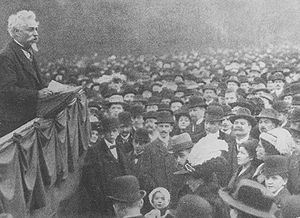
The revolution in Bavaria, which happened two days before the overthrow of the Reich capital, began at the end of October 1918 with the mutiny of the German deep-sea fleet. The Russian October Revolution of 1917, however, was already symbolic in retrospect.
The prehistory also includes the division of the German labour movement. As early as 1916, an opposition group had formed within the Munich SPD, which questioned the official view that Germany was waging a defensive war against Russia and France, which was allied with Russia (cf. "Kriegsschuldfrage" article (The War Blame Question). The rapid end of the war and renunciation of reparations and annexations was therefore demanded under the leadership of the journalist Kurt Eisner, who also included freethinkers such as Erich Mühsam (1878-1934), Josef Sontheimer (1867-1919) and Oskar Maria Graf (1894-1967) in his circle.
After the SPD split in early April 1917, the Eisner supporters joined the newly founded Independent Social Democratic Party of Germany (USPD). In January 1918, they succeeded in leading the Munich armament workers into a revolt lasting several days, which was already aimed at overthrowing the monarchy but ended with the arrest of the strike leaders.
When Eisner was released from custody in mid-October 1918 because the USPD had nominated him as a candidate for the upcoming by-election to the German Reichstag in Munich, he continued his agitation.
The Events of 7/8 November 1918
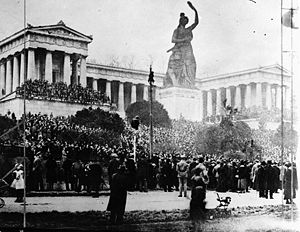
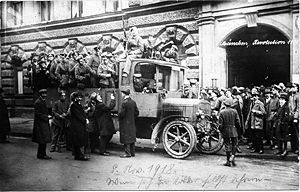
The revolution in Munich began with a peace demonstration on Theresienwiese in Munich, which the two workers' parties and the Free Trade Unions had called for on 7 November 1918. According to official estimates, between 40,000 and 60,000 people took part in the event, which was attended by union members in closed formations. However, the attempt by the (majority) Social Democratic Party (SPD) and trade unions to keep the Eisner supporters in check through the preponderance of their own followers failed completely. While the mass of demonstrators organised a demonstration through the city, a comparatively small group of independents at the command of Felix Fechenbach (1894-1933) successfully tried to win over the soldiers in the inner-city barracks for the overthrow. In a very short time, there were no more units in Munich that could have been mobilised against the revolutionaries. The insurgents were therefore able to occupy important facilities in the city centre such as the main railway station, the telegraph office and the Bavarian Landtag. A workers' council and soldiers' council were formed in the Mathäserbräu; a first joint meeting was held in the Landtag.
-
Announcement of the establishment of the Workers' and Soldiers' Council. (Monacensia. Literaturarchiv und Bibliothek - Monacensia. Literature Archive and Library)
-
Proclamation of the Bavarian Republic and deposition of the House of Wittelsbach on 8 November 1918. (bavarikon) (Bayerisches Hauptstaatsarchiv - Main State Archive of Bavaria, Plakatsammlung 2076).
The Constitution of the Provisional National Council and the Formation of a Revolutionary Government
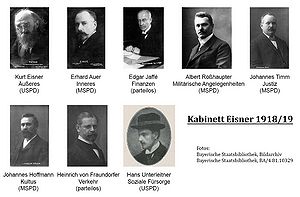
The Free State of Bavaria (“Freistaat Bayern”) was proclaimed in the appeal that Eisner drew up in the night of 7 to 8 November. As the announcement of early elections made clear, Eisner understood it as a parliamentary democracy. The Provisional National Council was to represent the interests of the people until the National Assembly was convened. In addition to the representatives of the councils, it also included members of the Landtag from the Social Democratic Parties, the Bayerischer Bauernbund (Bavarian Farmers' League) and the Liberale Vereinigung (Liberal Association). The new Bavarian government, previously negotiated between the SPD and the USPD, was confirmed in office by acclamation at its first meeting on 8 November. With a total of four ministers, the SPD had a preponderance in the Eisner cabinet:
| Name | Biographical data | Party | Office |
| Kurt Eisner | 1867-1919 | USPD | Minister-President and Minister of State of the Exterior |
| Edgar Jaffé | 1866-1921 | USPD | Minister of State for Finance |
| Erhard Auer | 1874-1945 | SPD | Minister of State for the Interior |
| Johannes Hoffmann | 1867-1930 | SPD | Minister of State for Education and Culture |
| Johannes Timm | 1866-1945 | SPD | Minister of State for Justice |
| Hans Unterleitner | 1890-1971 | USPD | Minister of State for Social Welfare |
| Heinrich von Frauendorfer | 1855-1921 | politically independent | Minister of State for Transport Affairs |
| Albert Roßhaupter | 1878-1949 | SPD | Minister of State for Military Affairs |
Since the new government exercised extensive executive and legislative powers, the Provisional National Council cannot be considered a full parliamentary body. It was supplemented by further delegates from various committees and interest groups over the following days.
The Spread of the Revolution throughout the Rest of Bavaria
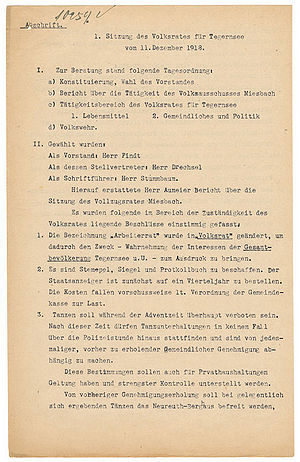
The revolution quickly spread from Munich to the other industrial centres in Bavaria. For example, Nuremberg's military units joined the movement on November 8 and elected soldiers' councils. A provisional workers' and soldiers' council was formed with the participation of the SPD and USPD, while the city council committed itself to the new republican order. From there the revolution also spread to Fürth (8 Nov) and Erlangen (9 Nov). In Augsburg, the news from Munich also led to the formation of a soldiers' council under the leadership of the Social Democrat Ernst Niekisch (1889-1967) on 8 November and, following on from this, to the constitution of a workers' council. Würzburg and Ludwigshafen followed on the same day.
Within a few days almost all the larger municipalities, at least if they had military facilities, and the industrial conurbations were controlled by councils. The studied structural characteristics of the revolutionary events in Munich were repeated: the movement was often triggered by a military revolt. However, the movement gained political impetus due to the workers' parties taking the reins. Mayors, city councillors and heads of administration declared their willingness to cooperate and generally remained in office and position afterwards. Since there was no resistance worth mentioning, the revolution happened without any bloodshed in almost all cases. The rural countryside, however, did not join the revolutionary movement, or only did so much later and often under circumstances that left local balances of power untouched.
Stages of the Revolution I: Minister-President Kurt Eisner's Term of Office (8 November 1918 - 21 February 1919)
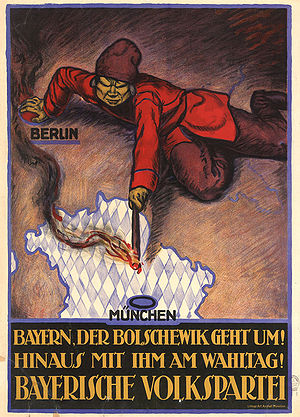
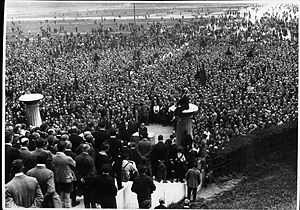
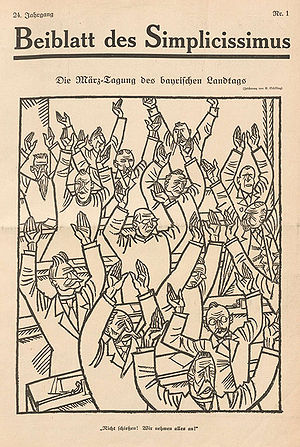
The revolution in Bavaria took place, roughly speaking, in three stages, characterised by increasing political radicalisation and accompanied by growing social tensions. The first stage, ranging from the proclamation of the Free State to the assassination of Eisner, was marked by the fact that although a parliamentary body had been created with the Provisional National Council, the government acted primarily under revolutionary law. Its term in office was initially largely quiet. The fall of the monarchy met with no serious objection. The rapid restoration of peace and order was positively received well into the bourgeois camp. The new government had submitted a work programme with consensus on the following points:
- Announcement of parliamentary elections
- Programmatic renunciation of drastic socialisation measures
- Canvassing for moderate peace conditions with the Allies
- Vision of a federalistically structured Germany including Austria
- Plan for the separation of church and state
- A strong emphasis on contemporary issues such as demobilisation, food supply and job creation.
The main controversial issue was the date for the Bavarian National Assembly elections.
The elections on 12 January 1919 (in the Palatinate: 2 February) exposed Eisner's USPD as a splinter group. As a result, the government found it increasingly difficult to legitimise its political decisions. The political conflict came to a head almost immediately. While the extreme left destabilised the situation through pressure from the street and violent attacks against members of the government and press organs, the bourgeois right contributed to inflaming the mood primarily through its media presence. Controversial topics were the future role of the councils, the establishment of a vigilante army and Eisner's admission of Germany's war guilt.
Stages of the Revolution II: From Eisner's Assassination to the Proclamation of the Munich Soviet Republic (21 February - 7 April 1919)
It was Eisner's assassination that led to a radicalisation that endangered the existence of democracy. It ushered in a second phase of revolution, which lasted until the proclamation of the soviet republic and was marked by political disorientation and a significant power vacuum. For the first time, the councils gained a decisive influence over political events.
The congress of Bavarian workers', soldiers' and peasants' councils, which met in Munich from 25 February to 8 March, initially provided crucial impetus. The government appointed by it under Martin Segitz (1853-1927), however, did not work as the SPD withdrew its members. After the Council Congress dissolved itself, the permanent bodies set up by it, the Central Council and Action Committee, became the social democratic parties' negotiating partners. However, it was not until mid-March that a compromise was reached, which was also approved by the MPs of the BVP (Bayerische Volkspartei - Bavarian People's Party).
Johannes Hoffmann was elected new Minister-President by the Landtag on 17 March. The next day he introduced his cabinet, which consisted of four majority social democrats, two independents, a Bauernbund member and a non-partisan:
| Name | Biographical data | Party | Office |
| Johannes Hoffmann | 1867-1930 | SPD | Minister-President, Minister of State of the Exterior, Minister of State for Education and Culture |
| Martin Segitz | 1853-1927 | SPD | Minister of State for the Interior |
| Fritz Endres | 1877-1963 | SPD | Minister of State for Justice |
| Ernst Schneppenhorst | 1881-1945 | SPD | Minister of State for Military Affairs |
| Hans Unterleitner | 1890-1971 | USPD | Minister of State for Social Welfare |
| Joseph Simon | 1865-1949 | USPD | Minister of State for Trade, Industry and Commerce |
| Martin Steiner | 1864-1950 | Bauernbund | Minister of State for Agriculture (from 1.4.1919) |
| Heinrich von Frauendorfer | 1855-1921 | politically independent | Minister of State for Transport Affairs |
The Ministry of Finance remained vacant for the time being. The government was given far-reaching legislative powers through enabling and emergency laws. However, since the parliament subsequently adjourned indefinitely, the government lacked the political backing to assert itself against the councils' continuing claim to power.
Stages of the Revolution III: The "Bavarian" Soviet Republic (7 April - 1 May 1919)
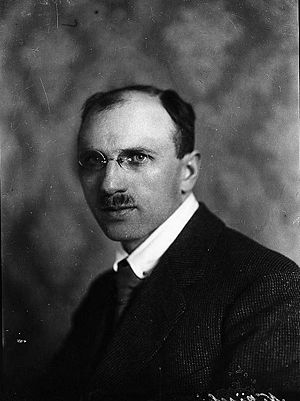
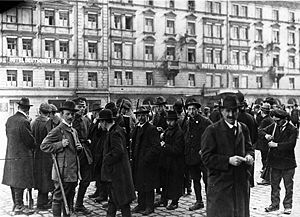
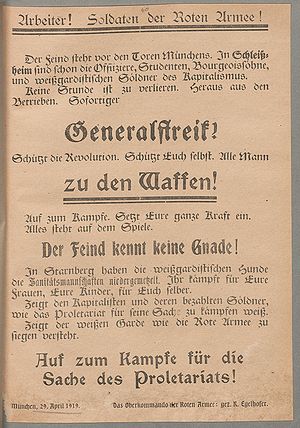
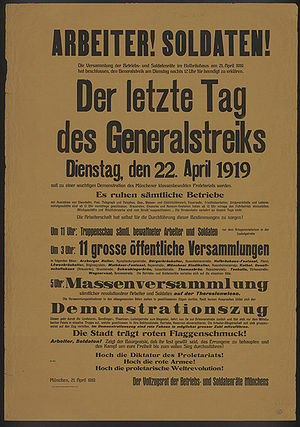
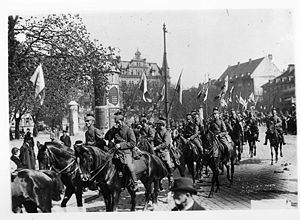
The situation escalated because the extreme left increasingly gained weight on the councils and enforced the proclamation of the "Bavarian" soviet republic in a joint meeting of the Central Council and Revolutionary Workers'Council on April 7. The government was then forced to flee to Bamberg. The fact that the Landtag then also left the state capital revealed the powerlessness of the government and parliament and gave the revolutionaries in Munich a free hand. Other cities throughout Bavaria joined the experiment. Ultimately, however, the renunciation of parliamentarianism was largely restricted to Augsburg, Munich, Rosenheim and their catchment areas. The soviet republics in the other administrative districts, including those in Hof and Würzburg, were immediately defeated or gave up after a short time.
The council rule, which lasted from 7 April to 1 May, broke up into several stages in Munich. Its first was determined by Ernst Niekisch (1889-1967), member of the SPD, independents such as Carl Kröpelin (1893-1977) and Ernst Toller (1893-1939), as well as anarchists such as Gustav Landauer (1870-1919) and Erich Mühsam. It ended on 13 April, when the Republican Defence Force, under the command of Alfred Seyffertitz (1884-1944), launched an ultimately unsuccessful counterstrike (Palm Sunday Coup). In response to this, the leaders of the KPD felt compelled to seize the reins against their better judgement. With Eugen Leviné (1883-1919) and Max Levien (1885-1937) at the head of the newly formed executive council, they organised the defence of the city and had civilian hostages detained at the Luitpoldgymnasium.
In the days of the violent conquest of Munich by Reichswehr and Freikorps paramilitary units, power passed completely to the Red Army under Rudolf Egelhofer's supreme command (1896-1919). This period must be described as a phase of civil war.
Parliamentarianism or Soviet Republic?
Kurt Eisner announced the convening of a constituent National Assembly on the night of the revolution. The governmental programme published by him on 15 November and the constitution of 4 January 1919 underpinned this promise. The constitutional lawyers Josef von Graßmann (1864-1928) and Robert Piloty (1863-1926), who were commissioned to draft a constitution, also guaranteed the implementation of a parliamentary constitution. Even the majority of the workers', farmers' and soldiers' councils were in favour of convening the Landtag. However, the role of the councils in the future constitution remained unclear until the end. Since the government did not promise them legislative or executive powers, the councils could at best be given political opinion-forming, authority supervision or employee representation functions.
It was only after Eisner's assassination that the parliamentary system was increasingly called into question. This gradually brought the transformation of the community into a socialist state within reach. The experiment failed because it only met with a significant response in Upper Bavaria and Swabia.
The Relationship between the Reich and Federal States
The Revolution of November 1918 was an all-German phenomenon and therefore had far-reaching consequences for the relationship between the Reich and the federal states. Bavaria was hit particularly hard by this as its reserved rights in the German Empire had given it a privileged status that fundamentally shaped the country's self-image.
It was fitting that Eisner, in his deep-seated distrust of Berlin, championed resolute federalism, even though German social democracy otherwise held a rather centralist view of the state. Cooperation with the other southern German states of Baden, Württemberg and Hesse therefore seemed possible. However, at the Stuttgart Conference of 27 December 1918, it became apparent that their governments did not share Eisner's decided anti-centralism any more than his view of the complete demise of the German Reich.
The assassination of Eisner, the proclamation of the soviet republic and the need to call for Reich military units to suppress it paralysed Bavaria during a decisive phase of the negotiations on the Weimar Reich Constitution. Johannes Hoffmann's government no longer resisted the draft constitution presented by Hugo Preuss (1860-1925). The withdrawal of the reserved rights and the marginalisation of Bavaria in German domestic and foreign policy considerably weakened the acceptance of the Republic of Weimar by the Bavarian population.
Socialisation of the Means of Production?
Immediately after the revolution, Kurt Eisner had rejected demands for socialisation of the means of production with the argument that it was not possible to socialise where nothing could be socialised because of financial ruin. Subsequently, his government was also only half-heartedly devoted to this issue. Widespread expectations were finally met by setting up a Socialisation Commission headed by the bourgeois social scientist Lujo Brentano. It focused on finance, banking, heavy industry, energy and large agricultural property.
On 27 March 1919, i.e. shortly before the proclamation of the soviet republic, the Hoffmann government finally decided to establish a Central Economic Office. The management was entrusted to the Viennese economist Otto Neurath (1882-1945). Neurath began to implement the full socialisation he fought for, against the declared will of Minister-President Johannes Hoffmann but with the support of the other cabinet members. During the early phase of the soviet republic he was promoted to a member of the Munich Council of Ombudsmen, where he was assisted by Silvio Gesell (1862-1930), the inventor of the theory of depreciative money, who was responsible for finances. The laws and ordinances issued by Neurath in the first half of April became invalid due to the suppression of the soviet republic. Socialisation was therefore no longer a serious issue in Bavaria in the long term.
Separation of Church and State
One fundamental innovation for state and society was the separation of state and church introduced by the Eisner government and pursued by the Hoffmann government. It gave religious communities a previously unknown independence, but also confronted them with painful innovations. Nowhere did this become as clear as in the field of education. A cornerstone of the state church system characteristic of the Kingdom of Bavaria was abolished with the ecclesiastical supervision of primary schools as early as 1 January 1919. Johannes Hoffmann, the new Minister of Education and Cultural Affairs, was not satisfied with the introduction of subject-specific supervision. On the contrary, the influence of the church on teacher training was eliminated and participation in religious education was left to the parents to decide. There could also be little doubt that Hoffmann preferred the non-denominational school to the denominational school. He made the Catholic Church in particular his irreconcilable adversary as a result. The Munich Archbishop Michael von Faulhaber (1869-1952), the formative figure of Bavarian Catholicism, never missed an opportunity to rage against the revolution and its constitutional programme ("Government of Jehovah's Anger").
By contrast, it hardly played a role in public discussions that with the ejection of the churches from schools the state's intervention rights in internal church affairs, on the Catholic side for instance the right of nomination for new appointments of episcopal sees, were up for negotiations.
The Transformation of the Party Landscape
The revolution also brought fundamental changes for the parties. In the system of representative democracy, they were no longer just organs for forming political opinions but they were the determining political authorities.
The overthrow also led to a gradual reshaping and differentiation of the party landscape in general:
- First of all, the splitting of the Social Democratic Party into (majority) Social Democrats (SPD), Independents (USPD) and Communists (KPD) was noticeable and contributed considerably to the weakening of the political left in the medium term.
- The founding of the Bayerische Volkspartei (BVP - Bavarian People's Party), which not only saw itself as an alternative to the socialist camp but at the same time distanced itself from the mother party, the Deutsche Zentrumspartei (“Zentrum” - German Centre Party), proved to be of lasting importance. The resolute demarcation against leftists, the emphatically Christian-conservative orientation but also the distance to the changing coalitions ruling in Berlin proved to be a successful model and made the BVP the dominant force of the interwar period in Bavaria.
- The Bayerischer Bauernbund (BB - Bavarian Farmers' League) remained in existence, initially even becoming the ruling party, but subsequently no longer achieved its former importance.
- The liberal camp was characterised by the division into a right-wing (Deutsche Volkspartei/DVP - German People's Party) and a left-liberal wing (Deutsche Demokratische Partei/DDP - German Democratic Party).
- Initially, the majority of the conservative right was concentrated in the newly founded Bayerische Mittelpartei (BMP - Bavarian Centre Party), which joined the Deutschnationale Volkspartei (DNVP - German National People's Party) in March 1920.
- On the right wing, the polarisation of the party landscape was completed by the formation of a nationalist camp. National chauvinist and rebel forces, which had initially formed the Freikorps paramilitary units or secret societies such as the Thule Society, found their political mouthpiece in the Deutsche Arbeiterpartei (DAP - German Workers' Party), later transformed into the Nationalsozialistische Deutsche Arbeiterpartei (NSDAP - National Socialist German Workers' Party).
The Results of the Revolution
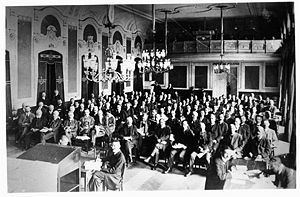
The revolutionary phase in Bavaria came to an end with the suppression of the soviet republic. In the medium term this also meant the end of the workers', soldiers' and farmers' councils. Other achievements of the revolution, however, endured. For example, the elimination of the monarchy proved to be permanent. It was replaced by a parliamentary democracy with general, equal, direct and secret proportional representation. This meant not least that women were now also allowed to vote. The Kammer der Reichsräte (Chamber of Councillors of the Realm) and thus the remains of the Ständestaat with the associated political prerogatives of the nobility were eliminated.
The revolution also brought about fundamental and lasting changes for the religious communities, as it meant the end of state's sovereignty over the church. An even more massive break, however, was the end of the sovereign's church regiment for Protestantism. With the monarch it lost its head at the same time and thus a supporting pillar of its internal church constitution, which is why the Palatinate and Bavarian Protestant regional church each adopted a new constitution in 1921. That the religious communities profited massively from the separation of the spheres of church and state only became really clear after the adoption of the new Reich and Bavarian constitutions. For example, state interventions in the internal church affairs were dropped, at the same time the churches were admittedly granted a status under public law, which guaranteed not least the financing by taxes which were collected by the state. The price was the elimination of eccclesiastical supervision of schools and the right of parents to decide on their children's participation in religious education. On the other hand, the measures to eliminate the denominational school were reversed. The relationship between state and church was newly regulated by the Bavarian Concordat and the church treaties of 1924/25.
The concept of the welfare state was enshrined in the administrative structure for the first time with the creation of a Ministry of Social Welfare (ordinance dated 14 November 1918). Although the department fell victim to the administrative reform of 1928, it was revived after the end of the Second World War as the State Ministry of Labour and Social Welfare. A Ministry of Agriculture and a Ministry of Trade, Industry and Commerce were also established during the revolutionary period (1 and 3 April 1919 respectively).
For economic life, however, especially the introduction of the eight-hour day and the recognition of the right of state workers to form coalitions and strike brought innovations that were also noticeable in everyday life. In addition, cultural life and the media were largely freed from state supervision and censorship.
Long-term Political Implications of the Revolution
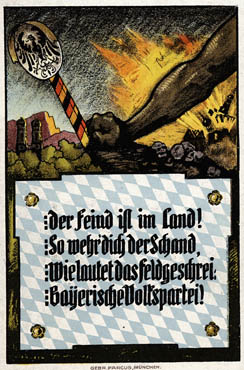
The revolution of 1918/1919 is often associated with the rise of National Socialism, which began in Munich. The effort to establish a stringent connection between the two phenomena is, of course, doomed to failure. However, this does not mean closing one's eyes to the disastrous political consequences that the revolution had especially in Bavaria. The political mobilisation of broad sections of the population in particular proved to be ambivalent. It not only led to fragmentation, but also to a polarisation of the party landscape, i.e. to the permanent establishment of both left- and right-wing radical groups. The anti-socialism deeply imprinted in the bourgeois camp by the experiences of the soviet republic prevented cooperation with the moderate left even in the final phase of the Weimar Republic, thus weakening the democratic camp.
The fact that after the defeat of the soviet republic the sovereignty of interpretation passed to the victors, i.e. ultimately the political right and the bourgeois-conservative camp, also proved fatal. The consequence of this was that the overthrow of the monarchy, which had been accepted by the majority as inevitable in November 1918, could henceforth be portrayed as the illegitimate act of a few foreign elements. Even the military defeat was blamed on the "unpatriotic fellows" from the political left (see Dolchstoßlegende). The falsification of the true causalities proved to be extremely effective and had fatal consequences for the acceptance of basic democratic order.
Film footage from the revolutionary period
-
Film of the funeral service on the occasion of Kurt Eisner's funeral, 26 February 1919 at bavarikon
-
Film about the government troops moving into Munich, early May 1919 at bavarikon
References
- Karl-Ludwig Ay, Die Entstehung einer Revolution. Die Volksstimmung in Bayern während des Ersten Weltkrieges (Beiträge zu einer historischen Strukturanalyse Bayerns im Industriezeitalter 1), Berlin 1968.
- Reinhard Baumann/Paul Hoser (Hg.), Die Revolution 1918/19 in der Provinz (Forum Suevicum 1), Konstanz 1996.
- Winfried Becker, Neue Freiheit vom Staat Bewährung im Nationalsozialismus: 1918-1945, in: Walter Brandmüller (Hg.), Handbuch der bayerischen Kirchengeschichte. 3. Band: Vom Reichsdeputationshauptschluss bis zum Zweiten Vatikanischen Konzil, Sankt Ottilien 1991, 337-392.
- Wolfgang Benz, Süddeutschland in der Weimarer Republik. Ein Beitrag zur deutschen Innenpolitik 1918-1923 (Beiträge zu einer historischen Strukturanalyse Bayerns im Industriezeitalter 4), Berlin 1970.
- Hans Beyer, Die Revolution in Bayern 1918/1919, Berlin (DDR) 2. Auflage 1988.
- Karl Bosl (Hg.), Bayern im Umbruch. Die Revolution von 1918, ihre Voraussetzungen, ihr Verlauf und ihre Folgen, München 1969.
- David R. Dorondo, Bavaria and German Federalism. Reich to Republic 1918-33, 1945-49, New York 1992.
- Freya Eisner, Kurt Eisner: Die Politik des libertären Sozialismus, Frankfurt am Main 1979.
- Rudolf Endres/Martina Fleischmann (jetzt: Bauernfeind), Nürnbergs Weg in die Moderne. Wirtschaft, Politik und Gesellschaft im 19. und 20. Jahrhundert, Nürnberg 1996.
- Martin H. Geyer, Verkehrte Welt. Revolution, Inflation und Moderne. München 1914-1924 (Kritische Studien zur Geschichtswissenschaft 128), Göttingen 1998.
- Bernhard Grau, Kurt Eisner 1867-1919. Eine Biographie, München 2001.
- Diethard Henning, Johannes Hoffmann. Sozialdemokrat und Bayerischer Ministerpräsident. Biographie (Schriftenreihe der Georg-von-Vollmar-Akademie 3), München u. a. 1992.
- Rudolf Herz/Dirk Halfbrod, Revolution und Fotografie. München 1918/19, Berlin 1988.
- Andreas Heusler, Die Behandlung der Sozialisierungsfrage in Bayern unter den Regierungen Eisner und Hoffmann 1918/19, masch. Magisterarbeit München 1988.
- Oliver Hochkeppel, Kriegsheimkehrer in München 1918 bis 1920. Untersuchungen zur Entstehung des "politischen Soldaten", masch. Magisterarbeit München 1990.
- Georg Köglmeier, Die zentralen Rätegremien in Bayern 1918/19. Legitimation - Organisation - Funktion (Schriftenreihe zur bayerischen Landesgeschichte 135), München 2001.
- Henning Köhler, Novemberrevolution und Frankreich. Die französische Deutschlandpolitik 1918-1919, Düsseldorf 1980.
- Eberhard Kolb, Die Arbeiterräte in der deutschen Innenpolitik 1918-1919 (Beiträge zur Geschichte des Parlamentarismus und der politischen Parteien 23), Düsseldorf 1969.
- Peter Kritzer, Die bayerische Sozialdemokratie und die bayerische Politik in den Jahren 1918 bis 1921 (Miscellanea Bavarica Monacensia 20), München 1969.
- Ursula Mertens, Die Rätebewegung in Bayern (1918/19), Diss. masch. Erlangen-Nürnberg 1984.
- Johannes Merz, Zur Sozialisierungsbewegung 1918/19: Konzeption und Wirksamkeit Otto Neuraths in Österreich, Sachsen und Bayern, in: Historisches Jahrbuch 121 (2001), 267-285.
- Allan Mitchell, Revolution in Bavaria, 1918-1919. The Eisner Regime and the Soviet Republic, Princton 1965.
- Martin Müller-Aenis, Sozialdemokratie und Rätebewegung in der Provinz. Schwaben und Mittelfranken in der bayerischen Revolution 1918-1919, München 1986.
- Helmut Neubauer, München und Moskau 1918/1919. Zur Geschichte der Rätebewegung in Bayern (Jahrbücher für Geschichte Osteuropas. Beiheft 4), München 1958.
- Franz Schade, Kurt Eisner und die bayerische Sozialdemokratie (Schriftenreihe der Forschungsstelle der Friedrich-Ebert-Stiftung B), Hannover 1961.
- Markus Schmalzl, Der Kongress der Arbeiter-, Bauern- und Soldatenräte in München (13.02.-08.03.1919), masch. Magisterarbeit Regensburg o. J. [2006].
- Klaus Scholder, Die Kirchen und das Dritte Reich. 1. Band: Vorgeschichte und Zeit der Illusionen 1918-1934, Berlin 1977.
- Michael Seligmann, Aufstand der Räte. Die erste bayerische Räterepublik vom 7. April 1919, Grafenau 1989.
- Manuela Siegl, Aspekte einer Rezeptionsgeschichte der russischen Oktoberrevolution und des Bolschewismusbegriffs in Münchner Quellen von November 1917 bis Mai 1919, masch. Magisterarbeit München 1990.
- Walter Tormin, Zwischen Rätediktatur und sozialer Demokratie. Die Geschichte der Rätebewegung in der deutschen Revolution 1918/19 (Beiträge zur Geschichte des Parlamentarismus und der politischen Parteien 4), Düsseldorf 1954.
- Werner Wagenhöfer/Robert Zink (Hg.), Räterepublik oder parlamentarische Republik. Die "Bamberger" Verfassung 1919, Bamberg 1999.
- Michael Weigl, Das Bayernbild der Repräsentanten Österreichs in München 1918-1938. Die diplomatische und konsularische Berichterstattung vor dem Hintergrund der bayerisch-österreichischen Beziehungen (Europäische Hochschulschriften III/1013), Frankfurt am Main 2005.
- Friedrich Weckerlein (Hg.), Freistaat! Die Anfänge des demokratischen Bayern 1918/19, München 1994.
- Siegfried Wenisch, Plakate als Spiegel der politischen Parteien in der Weimarer Republik (Ausstellungskataloge der Staatlichen Archive Bayerns 36), München 1996.
- Werner Gabriel Zimmermann, Bayern und das Reich 1918-1923. Der bayerische Föderalismus zwischen Revolution und Reaktion, München 1953.
- Wolfgang Zorn, Bayerische Geschichte im 20. Jahrhundert, München 1986.
Sources
- Karl-Ludwig Ay (Hg.), Appelle einer Revolution. Das Ende der Monarchie, das revolutionäre Interregnum, die Rätezeit. Dokumente aus Bayern zum Jahr 1918/1919, München 1968.
- Franz J. Bauer (Bearb.), Die Regierung Eisner 1918/19. Ministerratsprotokolle und Dokumente (Quellen zur Geschichte des Parlamentarismus und der politischen Parteien I/10), Düsseldorf 1987.
- Wolfgang Benz (Hg.), Politik in Bayern 1919-1933. Berichte des württembergischen Gesandten Carl Moser von Filseck (Schriftenreihe der Vierteljahrshefte für Zeitgeschichte 22/23), Stuttgart 1971.
- Tankred Dorst (Hg.), Die Münchner Räterepublik. Zeugnisse und Kommentar, Frankfurt am Main 3. Auflage 1968.
- Ernst Rudolf Huber/Wolfgang Huber, Staat und Kirche im 20. Jahrhundert. Dokumente zur Geschichte des deutschen Staatskirchenrechts. 4. Band: Staat und Kirche in der Weimarer Republik, Berlin 1988.
- Gerhard Schmolze (Hg.), Revolution und Räterepublik in München 1918/19 in Augenzeugenberichten, Düsseldorf 1969.
- Verhandlungen des Provisorischen Nationalrats des Volksstaates Bayern im Jahre 1918/1919. Stenographische Berichte Nr. 1 bis 10 sowie Beilagen 1-100, München 1918/1919.
- Hansjörg Viesel (Hg.), Literaten an der Wand. Die Münchner Räterepublik und die Schriftsteller, Frankfurt am Main 1980.
Further research
External links
- bavarikon Exhibition: Revolution and Soviet Republics in Bavaria 1918/19
- Deutsches Historisches Museum - Lebendiges Museum Online: Revolution von 1918/19
- Haus der Bayerischen Geschichte: Revolution! Bayern 1918/19
- Literaturportal Bayern: Schwerpunkt "Rebellisches Bayern"
Related articles
- Beisetzung Kurt Eisners, München, 26. Februar 1919
- Beisetzung Ludwigs III., München, 5. November 1921
- Trommeln in der Nacht (Bertolt Brecht, 1919)
- Lotter-Putsch, 19. Februar 1919
- Oratio pro rege, 1806-1918
- Palmsonntagsputsch, 13. April 1919
- Parlamentarische Reformversuche
- Regierung von Jehovas Zorn, 1918
- Unabhängige Sozialdemokratische Partei Deutschlands (USPD), 1917-1922
- Volksstaat Bayern
- Zweite Revolution, 1919
Alternative titles!
Cite
Bernhard Grau, Revolution, 1918/1919, published 9 May 2008, english version published 4 March 2020 ; in: Historisches Lexikon Bayerns, URL: <https://www.historisches-lexikon-bayerns.de/Lexikon/EN:Revolution,_1918/1919> (21.12.2025)

